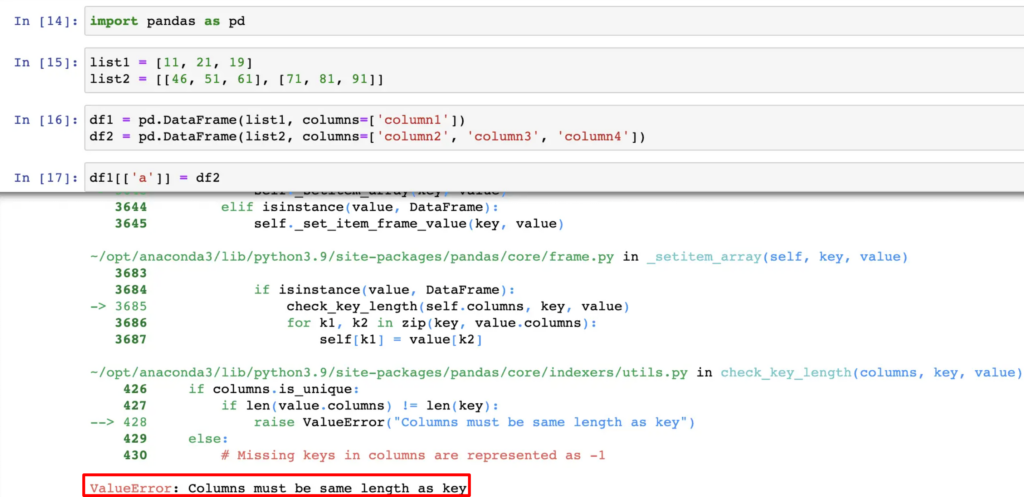ValueError: columns must be same length as key error occurs when are trying to create or modify a DataFrame and there is a mismatch in the lengths of the columns you are providing.
Here are two ways to fix the error:
- Esure that the length of the new column must match the number of rows in the DataFrame.
- Ensure the number of keys and the number of values in each row match and that each key corresponds to a unique value.
Flow diagram
Common reasons for the error
- If you are assigning a list-like object (like lists, tuples, sets, numpy arrays, or pandas Series) to a DataFrame’s columns, the number of elements in the list-like object must match the DataFrame’s row count. If these lengths don’t match, pandas can’t correctly align the data across the DataFrame’s structure.
- When assigning an entire DataFrame to a set of columns in another DataFrame, the number of columns in both DataFrames must match.
- When you attempt to replace the values of an existing column with a DataFrame (or a list-like object) whose number of columns doesn’t match the number of columns it’s replacing.
Scenario 1: Assigning a new column
import pandas as pd
# Existing DataFrame
df = pd.DataFrame({'A': [1, 2, 3], 'B': [4, 5, 6]})
# New column data
new_column = [7, 8] # Length is 2, but DataFrame has 3 rows
# Trying to assign the new column
df['C'] = new_column # This will raise the ValueError
print(df)
Output
ValueError: Length of values (2) does not match length of index (3)
How to fix it?
import pandas as pd
# Existing DataFrame
df = pd.DataFrame({'A': [1, 2, 3], 'B': [4, 5, 6]})
# New column data
new_column = [7, 8, 9]
# Trying to assign the new column
df['C'] = new_column
print(df)
Output
A B C
0 1 4 7
1 2 5 8
2 3 6 9Scenario 2: Creating a DataFrame from a list
import pandas as pd
list1 = [11, 21, 19]
list2 = [[46, 51, 61], [71, 81, 91]]
df1 = pd.DataFrame(list1, columns=['column1'])
df2 = pd.DataFrame(list2, columns=['column2', 'column3', 'column4'])
df1[['a']] = df2Output
How to fix it?
import pandas as pd
list1 = [11, 21, 19]
list2 = [[46, 51, 61], [71, 81, 91]]
df1 = pd.DataFrame(list1, columns=['column1'])
# Increase the number of rows in df1 to match the number of columns in df2
df1 = pd.concat([df1] * len(list2), ignore_index=True)
df2 = pd.DataFrame(list2, columns=['column2','column3','column4'])
df1[['column2', 'column3', 'column4']] = df2
print(df1)Output
column1 column2 column3 column4
0 11 46.0 51.0 61.0
1 21 71.0 81.0 91.0
2 19 NaN NaN NaN
3 11 NaN NaN NaN
4 21 NaN NaN NaN
5 19 NaN NaN NaNThat’s it!





